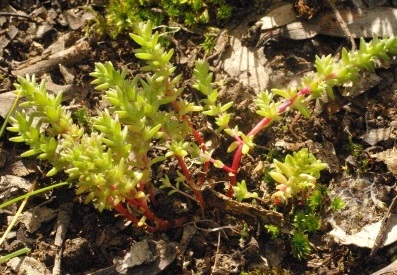Plants of the Castlemaine District
Dryland small stonecrops - mostly natives (Crassula species)

Sieber Crassula (Crassula sieberiana)
Spreading Crassula (Crassula decumbens)
Dense Crassula (Crassula colorata)
Three-part Crassula (*Crassula alata)
Stalked Crassula (Crassula peduncularis)
Family: Crassulaceae (Stonecrop family).
Natives of Australia, except the Three-part Crassula, which is native to the Mediterranean region.
Occurrence: The native crassulas are widespread and common in bushland, woodland and grassland. They may be abundant on roadside verges and gravelled areas. The introduced Three-part Crassula is uncommon, growing mainly in built-up areas.
Identification:
- they are small (usually 5 cm or less) succulents, with fleshy leaves and stems
- they are a green or red colour
- the flowers are not showy, and are small and with 3, 4 or 5 succulent petals
- the leaves are small (a few mm long) and more or less cylindrical.
Name. Crassula: thick, referring to the fleshy leaves and branches.
Flower parts in 4s or 5s
Sieber Crassula (Crassula sieberiana) An erect plant with short side-branches. Flower parts usually in 4s (and sometimes in 5s). Very common.Dense Crassula (Crassula colorata) An erect plant. It has "pimples" over much of the plant. The flower parts are in 5s. Uncommon.
Spreading Crassula (Crassula decumbens) A branched spreading plant, usually more or less prostrate. The flowers are shortly stalked. Very common.
Stalked Crassula (Crassula peduncularis) A branched spreading plant. Similar to Spreading Crassula, but the flowers are long stalked, and usually held above the leaves. Moderately common.
Flower parts in 3s
Three-part Crassula (Crassula alata) A diminutive spreading plant with flower parts in threes. It resembles Spreading Crassula, but is smaller. Introduced.Photo: Sieber Crassula.
Stonecrop photos
Swamp Crassula (Crassula helmsii) a wetland crassula